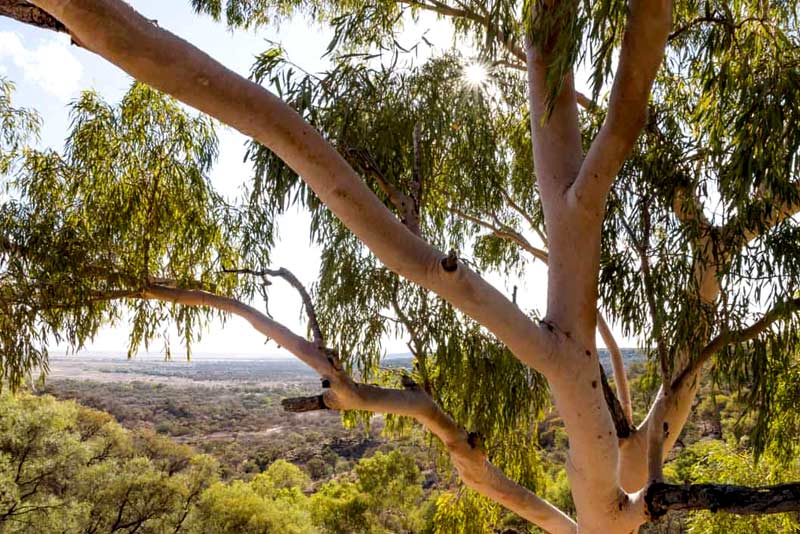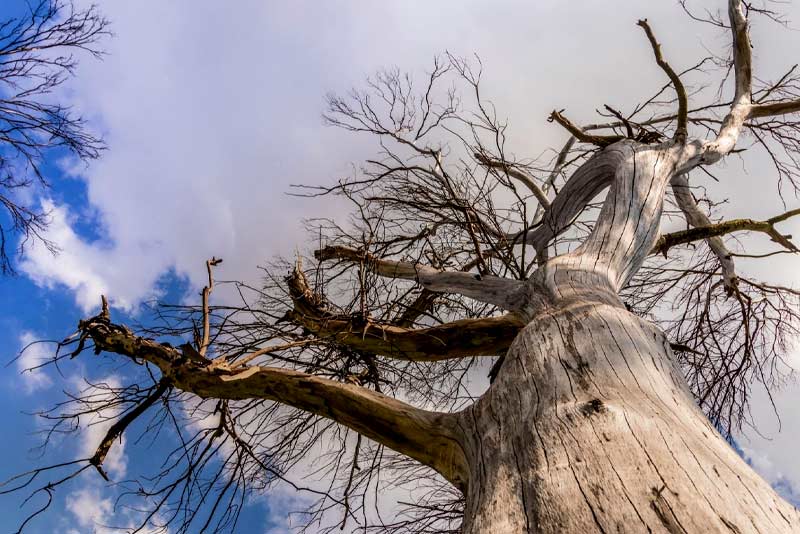You may have a gum tree in your yard currently shedding bark or with dead branches. Is this an early sign it is dying?
You can tell a gum tree is dying if you notice signs like a crown die-bark, cracks on the trunk, too much deadwood, parched soil, weak, brown, or spotted leaves, and pests.
Some of these signs do not necessarily mean a tree is dying. We go into more detail below about what to look for with the above signs.

Table of contents
ToggleSigns of a dying gum tree
There are more ways than one to identify a dying gum tree. If you have a eucalyptus that has lived up to 200 years, it may be nearing the end of its lifespan. While age is not the only factor that can lead to the tree dying, keeping in mind that it will eventually get old is crucial.
Brittle and lackluster bark
A tree that loses its color and luster may not be anything to worry about, especially if the season befits the occasion. Fall and winter cause trees to look less than they should be as they struggle to preserve themselves against the cold and dryness.
However, something is wrong when a tree becomes constantly brown without its usual luster and brightness. You may want to watch it for some time because a dying gum tree does not immediately wilt and fall. If the trend continues and it does not regain its color, it may be dying.
Cracked trunk
A cracked tree trunk is close to the heels of a brittle and dull bark. Sometimes, a tree has cracks on the trunk, which mean nothing. When the weather permits, the gaps close up as the tree becomes healthy and thrives. But if the cracks remain for a long time without closing up, the tree may be close to the end of its life.
Check the gum tree for these cracks on the trunk. Deep splits that reveal the inner parts or cavities of the trunk are a sign the tree is dying. If the exposed holes look dry and brittle, the tree may already be dead.
Unhealthy leaves
A healthy and thriving gum tree has green leaves. And when the weather drops or becomes too dry, the leaves fall off but grow again when the weather permits. However, the tree may be dying or dead if the leaves become spotty or brittle, even during the planting and growing season.
Also, if the leaves turn brown and weak but remain on the branches without falling off in fall or winter, it is a sign of a problem. Inspect the leaves if you suspect the gum tree is dying, even if there is no clear sign that they are stressed. Some streaks may look out of the ordinary, alerting you to a problem with the tree.
Too much deadwood
Seeing some deadwood around any tree is not worth mentioning. It happens all the time and is usually a sign a tree is healthy. The same applies to a gum tree. But when the tree begins to shed too much deadwood, so much that it becomes conspicuous, it may be a sign that it is dying.
You may want to pay attention to how much deadwood falls from the gum tree. If the amount increases and does not stop even in spring or summer, the tree may need to be cut down. The reason is that a dying or dead tree may crumble and fall at any point, making it a danger to people.
Parched soil
If the prevailing weather is dry, it may explain the dry soil around the gum tree. All you may need to do is water the soil to keep the roots hydrated. This method is typical during drought, but trees do not usually die due to dry soils unless the drought period extends.
But if the soil around the tree looks parched, it may be that the tree is not getting enough water. It may also mean the roots take more than the soil can offer without getting enough. The tree may die if manual watering or irrigation does not work.
Specific pests
If you notice certain pests on a gum tree, it clearly signifies the tree is dying. Pests such as carpenter ants and bark beetles are prevalent in weak, dying, or dead trees. Being familiar with these insects helps you recognize whether or not you need professional help. If you are unsure what they look like, it is best to let an arborist look at the tree.
Also, mushrooms growing on the trunk or roots indicate that the roots are rotting. The same is true if you find cankers on the trunk, which are depressed or discolored areas. Bacterial or fungal infections are signs the tree is dying. With time, the infections will spread to other parts of the tree and may cause more damage.
Other signs
A few other signs tell you a gum tree is dying. If the root looks discolored or damaged, have a professional look at the tree. Roots are not readily visible, so it may be a bit challenging to know whether or not it is suffering or the extent of the damage. The trick is to keep an eye on any exposed root part for signs of weakness or wear.
Additionally, improper balance or leanness is a sign the tree is stressed. It may be a gradual or sudden occurrence, but if the gum tree begins to look unbalanced or thin out, check its health. Typically, a weak tree will lean, but it may never recover if it bends beyond fifteen degrees from its vertical position. From there, it may eventually die.
Reasons a gum tree dies
A gum tree that has lived a long time is more likely to start dying than a young one. However, the death of a tree does not rest only on its age. Diseases and pests can abound and attack the health of a tree, but a few other factors also lead to a dying tree. Here are some of them.

Inadequate water supply
A gum tree is typically drought-tolerant, so it can comfortably live in dry areas. But like every other plant and tree, it needs some amount of water to survive or thrive. This is especially true if the tree has stayed for some time without water.
If you notice that your gum tree is not as fresh or thriving as it should be, the best step is to call an arborist. There are ways to ensure the tree does not die if it is not already too late. Another option is to hydrate the soil around it for some time. When the soil is moist enough, the roots should have enough supply of water to come alive again.
Too much water
On the other hand, a gum tree with waterlogged roots does not perform well. When too much water is in the soil, the roots begin to rot and eventually die. Since the roots are readily visible, you may not know the tree’s condition until it is too late.
However, if the leaves begin to turn yellow, even in the growing season, it is a sign the roots are not healthy. An arborist is in the best position to determine how to cut the water flow off so the tree can thrive better.
Insufficient sunlight
The eucalyptus tree needs a lot of sunlight to thrive. If there is any reason the sunlight reaching it is cut off, the tree may begin dying. It may be that a new sky-high building is shading some parts of the tree, affecting its growth and health.
If that is the case, you need the help of a professional to check the tree. They are in the best position to determine how best to ensure the tree receives as much light as it needs to live. Otherwise, the tree will wilt and die over time.
Not enough nutrients
If a gum tree has thrived enough on a patch of soil but suddenly starts dying, it may be due to a nutrient reduction. The eucalyptus plant can be a heavy feeder, depending on the species. Sometimes, the soil can become insufficient to supply the nutrients it needs, especially if other heavy feeders are planted on the same soil.
You may have to try a balanced fertilizer during the growing season on the soil. Apply it every month and increase it as needed. If the tree becomes healthier, you have your answer and may consider reducing the fertilizer application to avoid overdoing it.
A dying gum tree: a possible way to save it
When you notice vital signs that a gum tree is dying, it may be beyond salvation. However, before you draw your conclusion, employ an arborist’s services to determine the damage’s extent. They may help save by finding out what caused the problem. Moreover, the tree may still have some life, and the arborist can salvage it.
Sometimes, the tree may only be sick but look like it is dying to an untrained eye. A sick tree is salvageable because an arborist can check the causative agent and recommend a solution. While a sick gum tree may be dangerous around healthy trees, treating it early on can prevent the disease from spreading.










